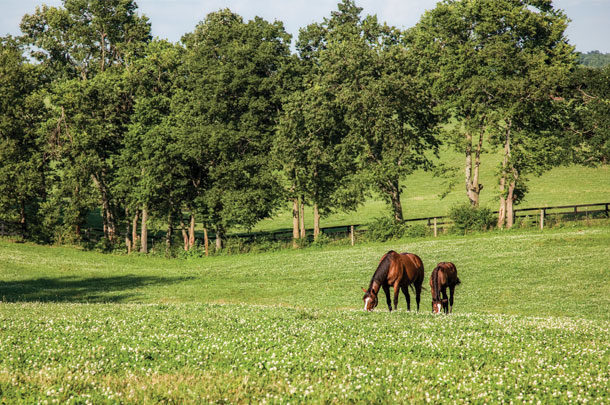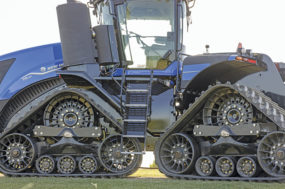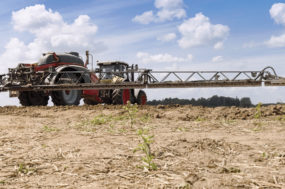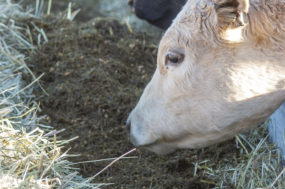A few years ago, I visited the beautiful area around Lexington, Kentucky, and spent time looking at, well, horses. And pastures. I saw fields of early spring grass with lots of horses playing and galloping.
But something intrigued me. At a couple of those horse farms, the owners spoke reverently about their forages. Actually, they talked about only one forage: Kentucky bluegrass. They said their horses did wonderfully on it, that it was the most nutritious grass in the world, that it was the basis of their entire farms. Hmmm, I thought, what am I missing?
I don’t believe in panaceas, but I also don’t argue with success, especially when the successful people are such considerate hosts. So during my farm visits, I kept my own counsel and ruminated about it for a while. I considered all sides of the issue. Finally, it came to me why Kentucky bluegrass is so important to those farms. It’s not the nutritional value. It’s something else, something more fundamental and profound than nutrition. In fact, the real reason demonstrates how on a farm, all the pieces, including the forages, must fit together to make a successful operation.
First, a textbook description of Kentucky bluegrass (KBG, Poa pratensis): KBG is a low-growing, sod-forming, cool-season perennial grass that grows well throughout the northeast and north-central U.S., often in conjunction with white clover (Trifolium repens). Persistent and winter-hardy, it has long, slim leaves with a characteristic boat-shape tip. Young shoots are folded. KBG has shallow roots and spreads by rhizomes.
It responds well to good fertility, although other forages like ryegrasses, orchardgrass or timothy will generally outyield it. KBG is also rather seasonal; its main growth periods occur in the spring and fall. During its unproductive period in midsummer, commonly called a “summer slump,” many other grasses will grow better, such as orchardgrass or tall fescue.
Nutritionally, KBG is nothing to write home about. Like any other grass, KBG is highly nutritious when the leaves are young and vegetative, but its nutritional value drops off rapidly as it matures. And recall that horses (even Thoroughbred racehorses) don’t have the high nutritional requirements of dairy cows or lactating ewes raising twins. Nearly any reasonable grass hay may be good enough nutritionally for these horses.
KBG excels, however, in one very critical trait: It can withstand close grazing. It will survive and flourish under set stocking conditions. This, of course, is one of the main reasons KBG is so common on many farms around the country.
But a farm is not a farm is not a farm, and Kentucky horse farms are quite different from New York dairy farms or Oregon cattle ranches. Kentucky horse farms specialize in raising fine thoroughbred animals where horses can be worth hundreds of thousands or even millions of dollars. These farms either own their own horses or board horses owned by others. They rear these animals, breed them, train them and sometimes race them.
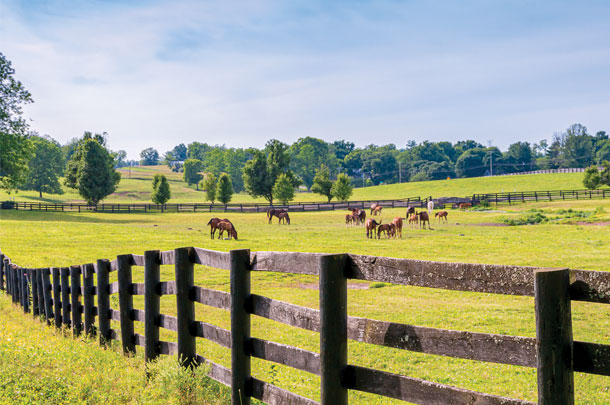
Getty Images.
All these horse farms contain rolling pastures where horses can run and graze. The forages in these pastures must provide feed for grazing, of course, and also some hay. KBG hay is no different than other grass hays: it can range from good to poor, depending on the date of cutting and the amount of rainfall. And KBG is not waterproof – a steady rain during hay harvest will soak KBG as much as any other grass.
But let’s think for a moment about the farms. What is the real product of these horse farms, and who is their market?
These farms don’t sell hay. They don’t sell feed. Yes, they do sell horses (at least the ones they own). But their real product is something that few other livestock farms can match – these horse farms sell an image. They sell the smell of liniment and leather; they sell the chance for a horse owner to lean over the railing at a track and watch horses run training laps, blowing steam in the early frosty mornings.
For some markets, image is nearly everything. Remember the cigarette commercials featuring the “Marlboro Man” or “Joe Camel” – two of the most successful advertising images in history? One portrayed dreams of the great glowing West; the other suggested an urban cool, the cocky boldness of James Dean. We may not all support the products presented in these images, but we can’t deny that they increased sales.
So for those Kentucky horse farms, who is their market? Investors. Investors who have lots of money. Investors who own million-dollar horses. Corporate executives, politicians, lawyers, doctors, investment bankers, professional athletes. And these folks must find places to board their horses. They look for farms that will train their horses, run them in races and give them the chance for a big payoff in the winner’s circle.
These are city folk who will come out to the farms on weekends to “talk shop” with the trainers and watch their horses gallop through the pastures. They want to see beautiful colts and fillies playing in lawnlike paddocks. They want to buy into an image.
Here’s the thing: These horse farms can provide that image. Their investors aren’t interested in the technical details of “grazing cells” or intensive grazing or forage management or the cost of hay. Let’s ignore the clubhouse complaints about the price of feed. These farms don’t need high-yielding pastures to produce hay. They can buy any hay they need. Paying an extra $30 per ton is a trivial expense when compared to getting a contract to board a million-dollar horse.
Therefore, high-yielding forages like orchardgrass or tall fescue would not suit these farms. These are bunch grasses that require careful grazing management, something that’s not easy to do with horses. No trainer would risk crowding thoroughbred racehorses tightly enough for controlled grazing – the animals would hurt each other or run into fences.
And using cattle or sheep to graze pastures is not an option, not on these farms, not with their image. But without good grazing management, bunch grasses would become clumpy and rank and weedy. There could be open muddy spots between the plants. Potential investors don’t want to see their horses struggling through the mud of a torn-up pasture.
But Kentucky bluegrass does the job nicely.
Kentucky bluegrass forms a tight sod that will hold down the mud and withstand the pounding of flying hooves. It persists year after year, even when continuously grazed by horses, who are notorious for destroying pastures. KBG can provide green, manicured paddocks, even though it doesn’t yield well under those conditions or provide excess nutrients for the animals. No wonder my hosts praised it. Better than any other forage, KBG helps them sell an image.
Young colts galloping on a spring green pasture. Manes flying in the wind. The promise of great races. Crowds rising to their feet as horses thunder into the final stretch.
Kentucky bluegrass.
